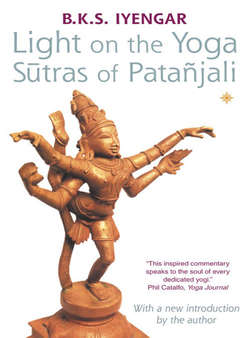Читать книгу Light on the Yoga Sutras of Patanjali - Литагент HarperCollins USD - Страница 58
I.1 atha yoganusAsanam
Оглавление| atha | now, auspiciousness, a prayer, a blessing, benediction, authority, a good omen |
| yoga | joining, union, junction, combination, application, use, means, result, deep meditation, concentration, contemplation of the Supreme Spirit |
| anusAsanam | advice, direction, order, command, instructions, laying down rules and precepts, a revised text, introduction, or guide given in procedural form. Thus, it means guidance in the codes of conduct which are to be observed, and which form the base from which to cultivate one’s ethical and spiritual life. |
With prayers for divine blessings, now begins an exposition of the sacred art of yoga.
Now follows a detailed exposition of the discipline of yoga, given step by step in the right order, and with proper direction for self-alignment.
Patañjali is the first to offer us a codification of yoga, its practice and precepts, and the immediacy of the new light he is shedding on a known and ancient subject is emphasized by his use of the word ‘now’. His reappraisal, based on his own experience, explores fresh ground, and bequeathes us a lasting, monumental work. In the cultural context of his time his words must have been crystal clear, and even to the spiritually impoverished modern mind they are never confused, although they are often almost impenetrably condensed.
The word ‘now’ can also be seen in the context of a progression from Patañjali’s previous works, his treatises on grammar and on ayurveda. Logically we must consider these to predate the Yoga Sutras, as grammar is a prerequisite of lucid speech and clear comprehension, and ayurvedic medicine of bodily cleanliness and inner equilibrium. Together, these works served as preparation for Patañjali’s crowning exposition of yoga: the cultivation and eventual transcendence of consciousness, culminating in liberation from the cycles of rebirth.
These works are collectively known as moksa sastras (spiritual sciences), treatises which trace man’s evolution from physical and mental bondage towards ultimate freedom. The treatise on yoga flows naturally from the ayurvedic work, and guides the aspirant (sadhaka) to a trained and balanced state of consciousness.
In this first chapter Patañjali analyses the components of consciousness and its behavioural patterns, and explains how its fluctuations can be stilled in order to achieve inner absorption and integration. In the second, he reveals the whole linking mechanism of yoga, by means of which ethical conduct, bodily vigour and health and physiological vitality are built into the structure of the human evolutionary progress towards freedom. In the third chapter, Patañjali prepares the mind to reach the soul. In the fourth, he shows how the mind dissolves into the consciousness and consciousness into the soul, and how the sadhaka drinks the nectar of immortality.
The Brahma Sutra, a treatise dealing with Vedanta philosophy (the knowledge of Brahman), also begins with the word atha or ‘now’: athato Brahma jijñasa. There, ‘now’ stands for the desire to know Brahman. Brahman is dealt with as the object of study and is discussed and explored throughout as the object. In the Yoga Sutras, it is the seer or the true Self who is to be discovered and known. Yoga is therefore considered to be a subjective art, science and philosophy. ‘Yoga’ has various connotations as mentioned at the outset, but here it stands for samadhi, the indivisible state of existence.
So, this sutra may be taken to mean: ‘the disciplines of integration are here expounded through experience, and are given to humanity for the exploration and recognition of that hidden part of man which is beyond the awareness of the senses’.
